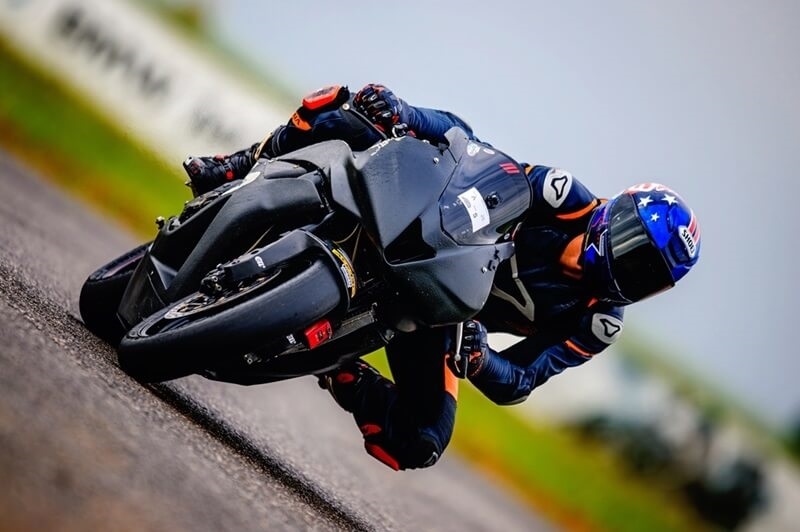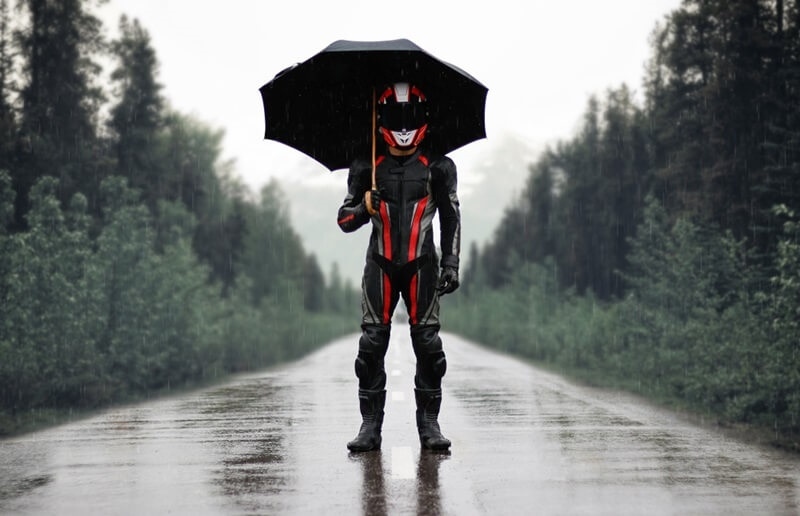Motorcycle Rain Gear Essentials – Stay Dry and Ride On

If you ride, eventually you'll be riding in the rain. That doesn't have to be a recipe for misery - with the proper motorcycle rain gear, you can stay dry, comfortable, and even enjoy riding in the rain rather than dreading it. Here, we'll walk you through what proper rain gear for motorcyclists is, how to choose it, how to maintain it, what waterproof jackets and pants are, and practical riding in wet weather strategies so that you can ride with confidence even if the skies open up.
Why You Need Proper Motorcycle Rain Gear
Let's start with the obvious: getting wet is no fun. But more than that, water can sap your concentration, drop your body temperature, and make controls slippery or your hands numb—all of which increase the risk.
Besides, riding in wet weather is just inevitable: commuter cyclists, long-distance tourers, or weekend warriors can't always wait out the storm. Having good gear ensures that a surprise rain shower doesn't hijack your ride - you just suit up and ride.
In short: good gear keeps you sharp, warm, dry, and visible when everyone else is running for cover.
Core Pieces - Waterproof Jackets and Pants

At the heart of your rain kit are rain jackets and pants, or full rain suits. The best allow you to ride in a rainstorm but minimize sweat and moisture buildup underneath.
What Makes a Jacket or Pants Truly Waterproof?
- Membrane or laminate technology - A waterproof-breathable membrane (like Gore-Tex, eVent, or house-brand fabrics) laminated between outer and inner layers is used in most premium jackets and pants. It blocks water entry while permitting moisture vapor to escape.
- Taped or sealed seams - The best membrane is defeated if water enters along stitching lines. Quality products have factory-taped or sealed seams.
- Storm flaps, water-resistant zippers, closure systems - Front zippers should be covered by flaps, cuffs and hems should seal securely, and ventilation zippers should be waterproof or covered.
- Cut and fit over your normal riding gear - Your rain jacket or pants should have room to fit over armored or textile riding garments, but still fit snugly to prevent billowing.
One-Piece vs. Two-Piece Rain Suits
- Two-piece suits (jacket + pants separately) offer flexibility. You can wear just the jacket in light rain or ride just the top half. You'll generally get a better fit and ventilation.
- One-piece suits provide simpler sealing, with fewer gaps at waist seams and more uniform coverage, but can be trickier to put on or manage ventilation. Many folks reserve one-piece suits for heavy, persistent rain.
Examples of Good Jackets & Pants
- Alpinestars Hurricane V2 – a good two-piece rain suit with a waterproof-breathable membrane, fully taped seams, synthetic mesh lining, and roomy leg zippers for boot clearance.
- Spidi touring rain suits – more comfortable fit by design, complete waterproofing via polyurethane-treated nylon, and good packability.
- Nelson Rigg Solo Storm Jacket & Pants – good value on a popular choice; seams are electronically taped, pant legs feature gussets for boot fit, and the jacket includes a soft tricot collar for reduced neck irritation.
When selecting waterproof jackets and pants, consider:
- True waterproofing (5,000 mm+ water column rating, or better yet, membrane systems)
- Good breathability (to prevent internal sweat accumulation)
- Adequate ventilation (pit vents, zip vents)
- Durability (reinforced panels, abrasion resistance)
- Ease of entry (zippers large enough to go over boots, etc.)
Supplemental Rain Gear - Beyond Jacket & Pants
To fully outfit yourself for wet-weather riding, you’ll want more than just the jacket and pants.
- Rain gloves or over-glove shells - Your normal gloves may soak through; waterproof glove shells or Gore-Tex gloves help maintain grip and warmth.
- Boot covers or waterproof boots - Dry from head to ankle makes a difference. Over-boot covers or waterproof boots prevent feet from getting wet from puddles, spray, or standing water.
- Neck gaiters, balaclavas, or waterproof liners - These can effectively close off water entry, reduce wind chill, and keep your core warm.
- Helmet visor and treatments - Tear-offs, Pinlock inserts, or anti-fog coatings maintain vision in the rain. Visibility is very important in rainy weather.
- Packable rain shells or emergency slickers - Bring a lightweight, packable shell even if your primary rain gear is heavy-duty, as insurance for changing conditions on a ride.
Quick-Dry Gear Review - What to Expect & Limitations
Even the best membranes can't perform miracles - sooner or later, moisture, oil, or wear will compromise performance. That's where the quick-dry gear review comes in. Here's what to keep in mind:
- Durable Water Repellent (DWR) coatings - The outer face fabric of the shell is typically treated with DWR so that water droplets bead up and roll off rather than soaking into the shell. But DWR degrades over time and must be restored. If it fails, water soaks into the fabric and blocks breathability.
- Venting is more crucial than ever - When it's raining, your body continues to sweat. If the gear isn't ventilating well, moisture builds up inside, and you become wet from the inside as much as the outside.
- Testing expectations - In reviews, even top-of-the-line rain jackets will eventually let a bit of moisture in during long, intense downpours. Some gear that's acceptable for an hour may leak after several. When testing waterproof or quick-dry gear, observe how it performs over time and in different amounts of rain.
- Maintenance matters - To preserve waterproofing, clean gently (avoid harsh detergents), dry thoroughly, and reapply DWR periodically. Even the best rain gear can fail if neglected.
- Weight and packability trade-offs - Ultra-light shells may pack small and weigh little, but often sacrifice durability or breathability. Heavier, more robust gear will protect better but bulk more.
If you read gear reviews (for example, in motorcycle gear magazines or online forums), pay attention to long-term performance, real-world riding tests (not solely laboratory tests), and how responsive the vendor is to repair or replacement.
Riding in Wet-Weather Tips to Match Your Gear
Good gear is half the answer - riding technique in the rain is just as crucial. Useful rain-riding techniques to help you stay dry:
1. Pre-Ride Check and Prep
- Lower tire pressure slightly (within safe limits) to improve wet grip.
- Inspect tire tread - slick or bald tires are riskier in the rain.
- Clean your chain - a dirty, dry chain flings gloopy grease when it's raining.
- Cover exposed controls (cables, levers) with appropriate lubricant.
- Store your rain gear in a waterproof bag or liner, so you can put it away dry when you're not using it.
2. Ride Slowly, not Faster
- Slow down - water reduces traction; braking and turns require more margin.
- Give no abrupt inputs - smooth steering, brakes, throttle.
- Brake early and slowly - anticipate stops, don't slam on the brakes.
Be wary of painted lines, metal plates, manhole covers, and road markings - they're even more slippery when wet.
3. Choose Your Line
- Avoid deep puddles - you can't always see potholes or debris beneath them.
- Use the drier lane tracks - cars will often clear a path through rain, and the track left by other bikes or cars may have more grip.
Be seen - rain reduces contrast, so stay in well-lit areas, use your lights, and wear high-visibility apparel.
4. Control Your Body Temperature and Visibility
- Vent when possible - open vents to allow internal moisture to escape.
- Beware of fogging - unvented helmets or layers can fog over rapidly; try using antifog liners.
- Keep warm - cold discomfort is distracting. Use insulating layers, but balance with breathability.
5. Post-Ride Care
- Remove and air-dry gear as soon as possible - don't leave wet gear bunched up in a bag.
- Check for leaks - look for seam or zipper failure.
- Reapply DWR when the surface no longer beads - most gear manufacturers sell spray or wash-in treatments.
- Store gear properly - hang or fold carefully, try to minimize sharp creases in membranes.
Conclusion
With some great rain gear and smart strategy, you can keep pedaling - dry, relaxed, and ready for whatever the skies toss your way. Good motorcycle rain gear is not just "a good idea" - it's one of the most important safety and comfort investments you can make for wet-weather riding.
This content was created by AI

